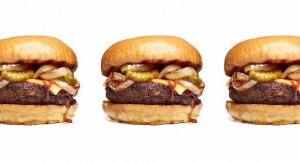
If the World Gives Up Meat, We Can Still Have Burgers
If the World Gives Up Meat, We Can Still Have Burgers
There’s a race on, of sorts, between two very different methods of curtailing our addiction to animal flesh.
If you accept that global meat consumption is a polluting, energy-hogging, climate-and-landscape-destroying problem, then the obvious question is: how do we fix it?
There are, it would appear, two answers to that question.
This week, China unveiled its approach: use the power of a strong central government to issue dramatic changes to your nation’s dietary guidelines, and back that up with everything from billboards to celebrity endorsements to get the word out. Chinese meat consumption has exploded in the last three decades, rising by almost a factor of five from around 30 pounds per person. The government’s plan is to encourage people to cut back to around 50 pounds per person—a measure that could save a billion tons of carbon emissions by 2030, if it works.
 Impossible Foods’ burger looks pretty good, doesn’t it?
Impossible Foods’ burger looks pretty good, doesn’t it?
In the U.S., such an option isn’t feasible—government efforts to change dietary guidelines are inevitably mired in resistance from food industry groups.
Instead, we are left to rely on the determination of people like biochemist Patrick Brown. Brown is the founder and CEO of Impossible Foods, a company that purports to have come up with a plant-based alternative to ground beef that, when cooked, is virtually indistinguishable from cow. Impossible Foods recently let Bloomberg cameras into their kitchen to create a rather mouth-watering video, along with similarly delectable imagery of their product—and unlike test-tube grown meat, in which a single burger costs north of a quarter million dollars, they appear to be able to produce their burgers in significant quantity.
Brown is not to be confused with the other California-based fake meat entrepreneur, Ethan Brown. Ethan heads Beyond Meat, which uses soy protein to create products designed to taste like chicken strips and ground beef. While the flavor might leave something to be desired, their Beyond Burger appears to be good enough to be flying off the shelves at Whole Foods in Colorado since its launch last month.
If one can judge based on a series of close-up, food-styled images and awestruck media coverage, Impossible would seem to have the slight edge over Beyond Meat. The cameras spend a lot of time on shots of Impossible’s ground beef alternative being molded into patties and watching it sizzle on the grill. The journalists swoon over the taste. This stands in marked contrast to Beyond’s burger patties, which look a bit like overcooked pancakes.
Impossible’s real edge, though, if it has one, may be that (Patrick) Brown has tracked down a compound called heme that’s derived from soybeans, and that he now gets from genetically modified yeasts. When refined it looks, flows, and apparently smells just like blood (it is, in fact, the same molecule that carries oxygen in our blood).
Whether or not these tech-fueled firms can build a meat alternative that will get us to kick our addiction to animal flesh—and the exorbitant amount of greenhouse gases emitted in the process of making it—is an open question. And while Impossible has raised $182 million in seed funding in pursuit of this goal, a lot of people think it’ll never happen.
But Impossible Foods’ Brown is, if you’ll forgive the expression, bullish. “If people are going to be eating burgers in 50 years, they’re not going to be made from cows,” he told NPR. “We’re saving the burger.”
(Read more: Bloomberg, The Guardian, NPR, Vox, “The Problem With Fake Meat”)

Leave a Reply